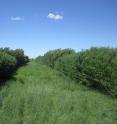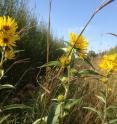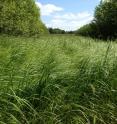Agroforestry helps farmers branch out
Related images
(click to enlarge)
Imagine an agriculture field. Most are planted with row upon row of tidy cash crops. Now imagine that same field with rows of trees between the rows of crops. This forested field concept is called alley cropping. Alley cropping helps farmers diversify by growing long-term tree crops alongside short-term cash crops like wheat. "For so long farmers have been taking trees off farmland," said Josh Gamble, agroforestry researcher at the University of Minnesota Twin Cities, "So the idea of putting trees back on is a little bit of a barrier."
Alley cropping is a type of agroforestry, which is the practice of combining crops and trees into one farming system. The dual income from the land can bring greater economic security to farmers.
"The idea is that it's potentially a multi-use system, with more diversity and more function," said Gamble.
Alley cropping is not only useful for diversifying a farm's income. Fields with trees capture more carbon than fields without trees. Trees protect the crops planted alongside them by providing shade and wind protection.
In addition, trees can provide a buffer between the field and nearby waterways. When a field floods, the water runs off with nutrients and soil, leaving the field less productive and the river more polluted. Trees can filter the nutrients and stabilize the soil on farm land.
Tree crops are used for a variety of products. Some, like pine, are grown for timber. Others, like hickory and walnut, can be used for nut production. Josh Gamble is interested in growing biomass, or trees and crops that are grown for heat and power production. Gamble and his team chose two fast-growing, hardy trees--willows and poplars-- and planted them alongside a variety of native grasses.
The willows, poplars, and grasses absorb excess nutrients, preventing them from leaching into waterways. The grasses are especially productive and absorb nutrients quickly. Because the grass is cut and removed from the land at harvest time, fewer nutrients are released back into the ecosystem. Additionally, the roots that remain after harvest help stabilize the soil and prevent erosion.
Gamble and his team wanted to find out which pairings of trees and grasses were most compatible. "Some species pairings work, and some compete against each other," said Gamble.
Poplar and prairie cordgrass were among the best-performing pairs, but Gamble said that might change. "These are only the first four years, so we'll see what happens," said Gamble. "We're trying to think about long-term productivity and diversity."
The trees and the grasses have to strike a truce for alley cropping to work well. "There's a fine balance between competition and sharing resources," said Gamble. Part of ensuring that balance is done by planting species that benefit each other. Warm- and cool-season species can benefit from the shade protection of trees to survive heat stress. It's also important to plant species that match the condition of the landscape. If a field is prone to flooding, farmers should plant species that can survive wet conditions.
Alley cropping adds a certain amount of complexity to the day-to-day management of farms, which can make it unappealing to some farmers. However, Gamble said that alley cropping is one technique in a broad suite of agroforestry tools that improve ecosystem function and boost productivity.
Source: American Society of Agronomy
Other sources
- Agroforestry helps farmers branch outfrom Science DailyThu, 7 Jul 2016, 2:21:26 UTC
- Agroforestry helps farmers branch outfrom PhysorgWed, 6 Jul 2016, 18:31:38 UTC
- Agroforestry Helps Farmers Branch Outfrom Newswise - ScinewsWed, 6 Jul 2016, 18:01:19 UTC


